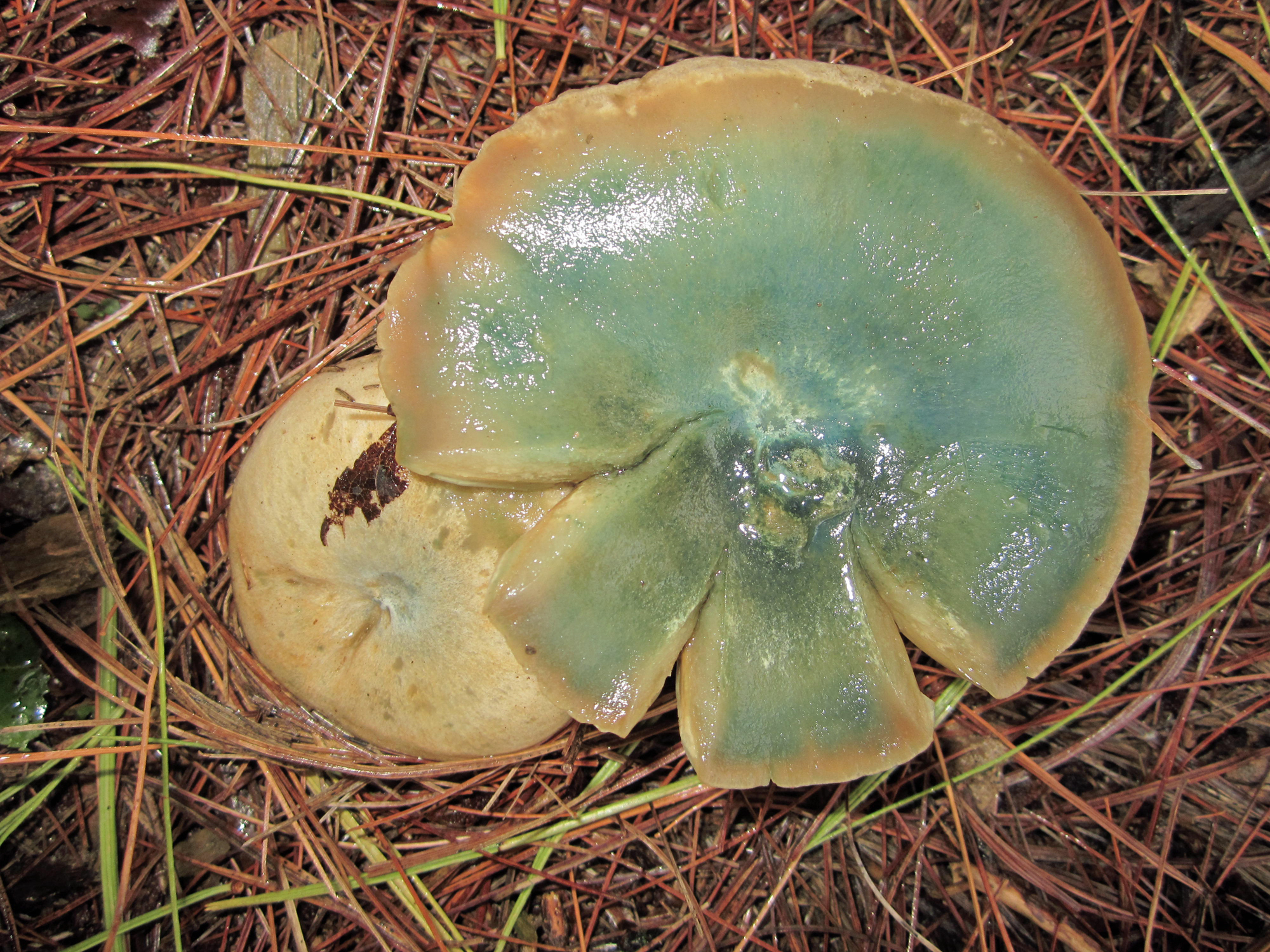Map Snapshot




20 Records
Status
Found scattered or in groups under pines, especially White Pine.
Description
Cap: Varied color from shades of yellow, tan, and orange to blues and greens; convex with incurved margin; viscid when wet; smooth; bruising or becoming green in age; flesh bruises blue mottled with yellow. Dingy yellow latex very scant. Gills: Tan to brown, often with green stains. Stalk: Colored like young cap; flesh orange. (J. Solem, pers. comm.)
Relationships
Edible, but flesh is frequently riddled with insect larvae (L. Biechele, pers. comm.).
Seasonality Snapshot
Eating mushrooms can be dangerous. One should do so only with expert advice and great care. MBP accepts no liability for injury sustained in consuming fungi or other biodiversity. Use of media featured on Maryland Biodiversity Project is only permitted with express permission of the photographer.
Celandine Lactarius (mature caps) in Howard Co., Maryland (10/3/2015).
View Record Details
Media by
Joanne Solem.
Celandine Lactarius (aging cap) in Howard Co., Maryland (10/3/2015).
View Record Details
Media by
Joanne Solem.
Celandine Lactarius (gills and stalk) in Howard Co., Maryland (10/3/2015).
View Record Details
Media by
Joanne Solem.
Celandine Lactarius in Montgomery Co., Maryland (10/1/2018). Determined by Jo Solem.
View Record Details
Media by
Anne Looker.
Celandine Lactarius (aging fruiting body) in Howard Co., Maryland (10/3/2015).
View Record Details
Media by
Joanne Solem.
Celandine Lactarius in Howard Co., Maryland (10/3/2015). Image includes split fruiting body showing flesh color in cap andrnstalk. Note insect damage in lower stem.
View Record Details
Media by
Joanne Solem.
A Celandine Lactarius in Worcester Co., Maryland (9/28/2014). Found in sandy soil under Loblolly Pine.
View Record Details
Media by
Lance Biechele.
Celandine Lactarius in Montgomery Co., Maryland (11/3/2020). (c) wearethechampignons, some rights reserved (CC BY).
View Record Details
Media by
wearethechampignons via iNaturalist.
Celandine Lactarius in Howard Co., Maryland (10/3/2015). (c) Joanne and Robert Solem, some rights reserved (CC BY-NC).
View Record Details
Media by
Joanne Solem.
Celandine Lactarius in Montgomery Co., Maryland (11/3/2020). (c) wearethechampignons, some rights reserved (CC BY).
View Record Details
Media by
wearethechampignons via iNaturalist.
Celandine Lactarius in Howard Co., Maryland (10/3/2015). (c) Joanne and Robert Solem, some rights reserved (CC BY-NC).
View Record Details
Media by
Joanne Solem.
Celandine Lactarius in Howard Co., Maryland (10/3/2015). (c) Joanne and Robert Solem, some rights reserved (CC BY-NC).
View Record Details
Media by
Joanne Solem.
Celandine Lactarius in Montgomery Co., Maryland (11/3/2020). (c) wearethechampignons, some rights reserved (CC BY).
View Record Details
Media by
wearethechampignons via iNaturalist.
Celandine Lactarius in Montgomery Co., Maryland (11/3/2020). (c) wearethechampignons, some rights reserved (CC BY).
View Record Details
Media by
wearethechampignons via iNaturalist.
Celandine Lactarius in Montgomery Co., Maryland (11/3/2020). (c) wearethechampignons, some rights reserved (CC BY).
View Record Details
Media by
wearethechampignons via iNaturalist.
Celandine Lactarius in Montgomery Co., Maryland (11/2/2020). (c) wearethechampignons, some rights reserved (CC BY).
View Record Details
Media by
wearethechampignons via iNaturalist.
Celandine Lactarius in Montgomery Co., Maryland (11/2/2020). (c) wearethechampignons, some rights reserved (CC BY).
View Record Details
Media by
wearethechampignons via iNaturalist.
Celandine Lactarius in Montgomery Co., Maryland (11/2/2020). (c) wearethechampignons, some rights reserved (CC BY).
View Record Details
Media by
wearethechampignons via iNaturalist.
Celandine Lactarius in Montgomery Co., Maryland (10/1/2018). Determined by Jo Solem.
View Record Details
Media by
Anne Looker.
Spores collected from a Celandine Lactarius specimen in Howard Co., Maryland (10/3/2015). Broadly oval, warted; measured 8.7-9.6 X 7.1-8.0 microns.
View Record Details
Media by
Robert Solem.
Spores collected from a Celandine Lactarius specimen in Howard Co., Maryland (10/3/2015). (c) Joanne and Robert Solem, some rights reserved (CC BY-NC).
View Record Details
Media by
Joanne Solem.
Source: Wikipedia
| Lactarius chelidonium | |
|---|---|

| |
| Scientific classification | |
| Domain: | Eukaryota |
| Kingdom: | Fungi |
| Division: | Basidiomycota |
| Class: | Agaricomycetes |
| Order: | Russulales |
| Family: | Russulaceae |
| Genus: | Lactarius |
| Species: | L. chelidonium
|
| Binomial name | |
| Lactarius chelidonium Peck (1872)
| |
| Synonyms[1] | |
|
Lactifluus chelidonium (Peck) Kuntze (1891) | |
Lactarius chelidonium is a member of the large milk-cap genus Lactarius in the order Russulales. It was first described by American mycologist Charles Horton Peck in 1870.[2]
See also
[edit]References
[edit]- ^ "Lactarius chelidonium Peck 1872". MycoBank. International Mycological Association. Retrieved 2011-06-06.
- ^ Peck CH. (1870). "Report of the Botanist (1870)". Annual Report on the New York State Museum of Natural History. 24: 41–108.




















